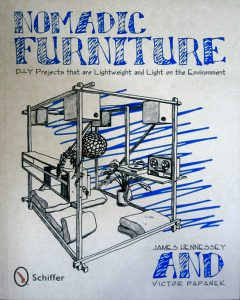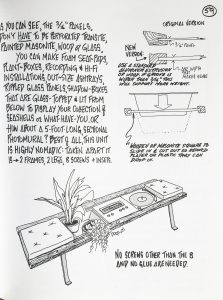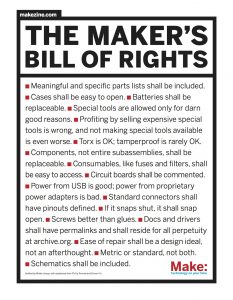The Subversive Capacity of Do-It-Yourself Instructions
Veronica Uribe Del Aguila
In June of 2013, the Museum for Applied Arts (MAK) in Vienna opened Nomadic Furniture 3.0: New Liberating Living? The exhibition looks to the Do- It-Yourself (DIY) furniture culture—a movement that started during the first half of the twentieth century and has been developing and evolving until the present day. One year later, at Parsons Paris, the exhibition Some Things in Common: From Enzo Mari to Open Culture (2014) reconsiders the traditional separation between designer, producer, and consumer to discover what things they hold in common. The exhibition links previous Do-It-Yourself practices to new technological open source practices and explores the ways in which technological innovations generate new forms of sharing that directly transform how designers design. Open from October 16th to November 13th, the displays in the exhibition also probed designers’ deeper concerns about access and justice, materiality and sustainability.
What these two exhibitions incisively tackle is the development of a recurrent alternative design model that has political features. In “Do It Yourself: Democracy and Design,” design historian Paul Atkinson states:
Historically, productive and creative activities of this kind have allowed consumers to engage actively with design and the design process at a number of levels, and to express a more individual aesthetic unbounded by the structures of mass production and passive consumption.1
By presenting a more accessible, sustainable and fair design practice, DIY culture challenges traditional design in three aspects: the design process, the lifestyle encouraged and imposed by it, and the model of production that frames it.2 Following political thinker Chantal Mouffe’s statements regarding the hybridization between spheres of labor, political action, and intellectual reflection, I argue that the current state of these practices is one of “novel forms of social relation in which art and work exist in new configuration.”3
The present article analyzes the role assembling instructions and written pieces of design play in DIY practices that articulated sustainable design practices and discourses with social justice ideas through the performance of an alternative model of production and consumption. I focus my research on three examples: Nomadic Furniture, Autoprogettazione? and “Make:,” and the ways in which they are used by designers and non-designers to generate a public forum for an alternative design practice and lifestyle.
A Third Object of the Design Process
Designed for users, assembling instructions visualize information such as processes and complex sequences. As Edward Tufte explains about magic tricks:
“[they] involve pictorial instructions demonstrating a sequence of performance, a step-by-step description of conjuring activities.” He goes on to say:
To document and explain a process, to make verbs visible, is at the heart of information design. (…) As is the case for all sorts of narratives, the explanation of magic tells a four-dimensional story, using words and images to navigate through time and three-space where conjuring activities take place.4
As magic tricks, assembling instructions make use of written words in two different ways: as signs—a pair of a signifier and a signified linked arbitrarily, and as images—where the link between signifier and signified is no longer arbitrary, but intuitive.5 Moreover many times the same word fulfills these two functions. Words are shaped in order to function as signs and images at the same time.6
Within DIY communities assembling instructions act as the performative counterpart to the discourse presented by designers and non-designers in other written formats, such as books and manifestos.7 They play a major role in determining and shaping the performative character of their practice.8 This is due to the fact that, as designed tools, they mediate the relations between designer, user and designed object.9
Bruno Latour’s notion of “script” further clarifies the performative, subversive, and critical capacities of assembling instructions. In terms of Latour’s work, “script” designates a command or program of action delegated to someone or something. Scripts are the outcomes of “inscriptions” by designers, who infuse prescriptions for use into the materiality of the product. These scripts transcend functionality; they form a surplus to it, which occurs once the design is functioning and depends on the unpredictable context of this functioning. Furthermore, scripts describe the manifold roles technological artifacts play in their context. Inscription, then, can be intrasomatic—incorporated in humans— or extrasomatic—incorporated in non-humans.10
“DIY practice finds itself in a contradictory intersection between need and desire, creativity and assemblage.”
Besides being hybrids of words and images, instructions are midpoints between imagined objects and made objects.11 In The Body in Pain, Elaine Scarry summarizes the attributes belonging to making.12 According to Scarry, the process of making an object entails two moments and hence its object consists of two forms. The first one is the form of something that does not exist—something imagined or fictional. It arises as a response to physical pain understood as the ultimate source of necessity—what could be more needed, desired, or imagined than food when one is starving? The second process is the transformation of this imagined object into a freestanding made object. Responding to a source of physical pain, this second object reflects and mimics the body it alleviates. This partition of “making” could easily be matched to the traditional design model of production. The design process resembles the first moment, and the production process the second. Assembling instructions materialize a third moment in the process of making—a third form of the object. This third form reveals the temporal dimension of the object by revealing its process of making.
Figure 1. Nomadic Furniture, Second Edition. Released in 2008, it contains both books released during the seventies. It also proves the current growing interest in these kinds of activities.
Figure 2. Active Prosumers: Instructions are often presented as recommendations and encourage creativity.
Since it makes a redistribution of competences among users possible (not only of users’ but also of producers’ and even designers’ competences), this third form of the object entails alternative design models of production that could question our current consumption practices. However, as DIY practices, assembling instructions are not subversive or challenging per se.13 Building on Jean Baudrillard, Steve Knott argues that the potential of this practice is ambiguous. Instructions could be designed to fulfill commercial interests and in that sense to perpetuate the endless consumerism of mass individualization.14 Since scripts are not complete until users perform them, it is only through users’ performance and the development of skills resulting from these activities that traditional economic relations and roles, along with the practice itself, are challenged, shaped, and changed. A categorization based on the quality and degree of participation in these activities is therefore necessary in order to determine their subversive capacity.
Atkinson provides the first taxonomy of DIY practices based on the motivation and the areas where these activities are conducted. The author distinguishes between two areas in which DIY projects are encountered: the making of an object and the maintenance of a house. In order to grasp the issue of democracy and freedom, he determines four categories based on the motivations for engaging in this activity: pro-active DIY (manipulation of raw material), reactive DIY (hobby or a handicraft mediated through the agency of kits or assemblages), essential DIY (home maintenance as an activity that is the result of an economic necessity), and lifestyle DIY (which implies a choice).15
Knott’s more recent taxonomy for determining the critical capacity of DIY activities focuses on the role of the user. In “Design in the Age of Prosumption: The Craft of Design after the Object,” he establishes three characterizations of prosumers (producing consumers) based on their degree of participation or agency. According to Knott, “prosumers’ agency depends on the level of engagement with the enticements that encourage such production: what tools are handed over to the consumer, what is 42 the political and social context of this transferal, and how does the newly empowered wield this productive power?”16
Compared to consumers or buyers who merely accept what is given to them, prosumers are inherently active. Within this active role, Knott recognizes three different profiles: those who follow the rules—this prosumption is overtly dependent on the tools, materials, and instructions, those who reject the rules as tools of capitalist consumer culture, and thirdly, prosumers who seek alternative and radically self-sufficient styles of living. Finally, there are those who adapt the objects and instructions provided to them by making conscious modifications of the rules. They see instructions as a basic foundation rather than a rulebook—a “vehicle of self-expression.”17
Nomadic Furniture, Autoprogettazione? And Make
Published in 1973 and 1974, Nomadic Furniture I and II: How to Build and Where to Buy Lightweight Furniture that Folds, Inflates, Knocks Down, Stacks or is Disposable or Can Be Recycled. With Many Easy to Follow Illustrations by Victor Papanek and James Hennessey falls into the second category. Two years prior, in Design for the Real World, Papanek offered severe critiques of product design and design in general. He states: “There are professions more harmful than industrial design, but only a very few of them.” He continues: “As long as design concerns itself with confecting trivial ‘toys for adults’ (…) it has lost all reason to exist. (…) Design must become an innovative, highly creative, cross-disciplinary tool responsive to the true need of men.”18 Nomadic Furniture is an attempt to gather products that respond to true human needs. Inspired by “The Whole Earth Catalog,” the book seeks to solve two apparently incommensurable conditions of contemporary human beings: their nomadic existence—which forced them to constantly consume and throw away, and their growing concern for the environment.Nomadic Furniture’s real value, according to its authors, is “that it will enable us nomads to have more by owning less.”19 Here, the authors address an already existing audience that needs lightweight furniture that folds, inflates, knocks down, stacks or is disposable, while being ecologically responsible. The readers, members of this imagined “nomadic” community, that also want to be ecologically responsible, have already made a lifestyle choice.20 The book only enables them to follow up with this decision—it provides them with the tools to accomplish a goal already set out by them. The format of the book, a catalog of assembling instructions, provides tools while encouraging creativity. It gathers vernacular designs and designers’ creations and suggests alterations, improvements, and alternative materials. For example, at the end of the table section the book presents two versions (a desk and a storage cabinet) of the folding campaign desk used by Spanish army officers before and during the Napoleonic wars.21 In many ways the book works as a proto-open-source project where designers present and suggest alternative designs for users to engage with or ignore.
Although they are reactions to a capitalist model, these practices are also understood as a vehicle for self-expression. The designers rely on the reflexive appropriation of knowledge and purposiveness by users; they invite users to creatively alter the process and the recommended materials. The instructions in the book often include paragraphs providing the reasons and the context for the designer’s decisions. In that sense, they help delegate designer’s competencies to users and establish a new relationship between them.
In the same fashion, Enzo Mari’s Autoprogettazione? (1974) began as a reaction to traditional capitalist means of production and the design practice that emerged from it. Like Papanek, Mari has a strong opinion about what design should be. For the Italian designer, “the quality-quantity ratio is central to the whole of industrial production: quality is determined when the shape of a product does not ‘seem’ but simply ‘is.’”22 In a 2010 interview for Artek, he explains why designers must observe nature. He states: “The form of nature is always perfect. The natural world cannot be any different from the way it is. The form of a hand (…) is always perfect because it is linked to the movement the hand has to carry out, its muscle and the power the hand has developed. (…) A hand is always accurate.”23
“The relation between designer/prosumer and prosumer/designer is transformed by the performative nature of instructions.”
In the second edition of Autoprogettazione? (2002) Mari further clarifies his motivation for starting the project. He says: “How is it possible to accomplish the deconditioning of form as a value rather than as strictly corresponding to content? The only way I know of, that it belongs to my field of experience is what becomes possible when critical thought is based on critical work (…). Only by actually touching the diverse contradiction of the job is it possible to start to be free from this deeply rooted condition.”24 In another passage he states: “In 1974 I thought that if people were encouraged to build a table with their own hands they would be able to understand the thinking within it.”25
Figure 3. Make: Homepage: The virtual platform gathers makers from all over the world and from diverse levels of expertise.
The book/instruction manual consists of twenty designs that can be built using wood boards and nails. The technique is simple and has a twofold aim. On the one hand it seeks to provide simple and effective instructions for building any of the pieces in the book. On the other hand, as Mari explains, it aims at “teaching anyone to look at present production with a critical eye.”26 The title, which means “Self-design?,” introduces a question that is addressed to both designers and users.
Although in the previous two examples the power structure between designer and user (or prosumer) somehow remained intact, new approaches to design infuse DIY practices with a more collaborative structure. As in the seventies, current instructions and DIY practices have begun standing out as an alternative, not only to passive consumerist practices, but also to top-down design practices. The Internet and other potentially democratizing new technologies such a virtual archives, hypertext, and 3D printers play an important role in this change. They reshape old practices by enhancing the possibility of collective action. Assembling instructions become a new hybrid made out of words, images, video, and hyperlinks that are permanently available for download on different virtual platforms such as YouTube and Vimeo. Consequently, they constitute the locus of broader and more diverse interactions between members of these communities of designers and non-designers such as those using the collaborative virtual platform “Make:.” The collective elaboration of meaning through an ongoing creation of instructions generates a public space where people articulate their own needs and new identities.
“This new notion of property challenges the current capitalist mode of production—the division of labor—which is the source of current established roles in design practice.”
Created in 2005 by Dale Dougherty, “Make:” started as a quarterly journal about DIY projects. One year later, Dougherty introduced a series of Maker Fairs, which became the first set of showcases for this community. Today, “Make:” is a community structured as an open source model—“a way of organizing production, of making things jointly.”27 Formed by designers, artists, engineers, and DIY enthusiasts, it has a strong physical dimension, although it uses the web as a platform for communication, coordination, and the transfer of innovation.
The community centers around the task of creating and improving tangible interactive electronic and non-electronic objects. Some instructions start with already made objects such as wooden pallets or open source electronic prototyping platforms such as “Arduino”—a single-board microcontroller simple enough to be sold as a DIY kit.28 Others start from scratch. Regardless of the style of instructions, they remain as the main tool for developing skills and are the space of interaction between the members of the community.
Instructions take on different forms: pictures, diagrams, step-by-step drop down instructions, videos, and hyperlinks. Instructions posted on the website often include a brief introduction that explains the design’s origins, context, and results. All this information helps other makers improve and adapt the design to their particular needs.29 Once again, the relation between designer/prosumer and prosumer/designer is transformed by the performative nature of instructions.
As in previous DIY communities, this kind of organization blurs the differences between work and leisure. Moreover, it introduces a more egalitarian platform of professional designers and amateurs. However, the use of the platform varies depending on the user’s skill level. Instructions and some groups within the community are categorized by the level of difficulty and skills required to perform a task. Every maker has a profile on the webpage which contains his or her designs, instructions, and skill level.
Figure 4. The Maker’s Bill of Rights. The alternative lifestyle of the maker is presented through different formats, some of them discursive.
Another critical aspect of this alternative model of design is a new understanding of property rights configured around its model of distribution. As Steve Weber states:
Private property rests on the ability of owner to alienate (…) the right to manage the thing or determine who can access it under what condition. (…) Open source radically inverts these core notions of property. Property in open source is configured fundamentally around the right to distribute not the right to exclude.30
This new notion of property challenges the current capitalist mode of production—the division of labor—which is the source of current established roles in design practice. The maker owns the code or instructions, however, users (makers or prosumers) have the freedom to adjust it to their own needs. Rules are yet to be established; there are different degrees of openness and ongoing discussions about the kinds of uses or modifications that someone can apply to somebody else’s design.
As in the previous examples, within the maker community instructions are the counterpart of a discourse that unfolds in other written formats. Although not as coherent as Mari and Papanek’s, due to the collaborative and pluralistic nature of the community, there is critique present among the many instructions uploaded on the virtual platform used by “Make:” members. Furthermore, this counter-narrative is not exclusive to “Make:”—which is a registered trademark. Mark Hatch, CEO at Techshop and author of the Maker Movement Manifesto, summarizes this imagined community’s ideology in ten main ideas: make, share, give, learn, tool up, participate, support, and change. According to Hatch, the movement’s core idea is as follows: “Making is fundamental to what it means to be human. We must make, create, and express ourselves to feel whole. There is something unique about making physical things. These things are like little pieces of us and seem to embody portions of our souls.”31 Making, along with sharing, giving, and learning are pointed out as fundamental aspects of these practices.
“By presenting a more accessible, sustainable and fair design practice, DIY culture challenges traditional design in three aspects: the design process, the lifestyle encouraged and imposed by it, and the model of production that frames it.”
DIY practice finds itself in a contradictory intersection between need and desire, creativity and assemblage. By challenging the classical distinction between praxis (the act of self-transformation) and poiesis (a necessary and servile action designed to produce or transform action) it questions the capitalist economy.32 Power relations established by the traditional politics of design—the market and the means of production—are disputed by this alternative. In that sense, the users’ role is not only to consume, but also, to some degree, to produce. The subversive potential of this kind of practice might also rest on the fact that they generate skills and knowledge, i.e. capabilities understood as control of the circumstances that make possible any skilled activity, as Otto Von Bush states.33 Designers are no longer the only ones writing the script; they delegate some of their critical reflective tasks to the user. In that sense, instructions foster agency and other forms of identification. Members of these communities are no longer consumers but prosumers. Furthermore, they are makers.
The means and tools of these activities and instructions reveal their political dimensions as potential tools for articulating a counter-hegemony. However, the ambiguous positions these practices present, regarding the current model of design production and consumption, is shown in the makers’ proclivity to disregard this dimension and in their attempts to commodify some of the aspects and elements of these practices. Definitions, such as the one provided by Hatch, are clear attempts to capitalize a movement that emerged as an alternative 50 model to capitalism. Furthermore, the merchandizing and branding campaign deployed by “Make:” reveals that the movement remains in a terrain that can easily become part of the current policy or hegemony as much as constitute a counter-hegemony of its own.
Endnotes
1. Paul Atkinson, “Do It Yourself: Democracy and Design,” Journal of Design History 19:1 (2006): 1. ↵
2. By “model of production” I refer to the most common ways in which designs are produced; a process of production that is separate from the product’s moment and space of use. I don’t think that this definition equals Marx’s term “mode of production” in its full scope since DIY activities could present different models of production that still fit the capitalist mode of production. Division of labor, for example, remains present in DIY activities. ↵
3. Chantal Mouffe, Agonistics: Thinking the World Politically (New York: Verso, 2013), 90. ↵
4. Edward Tufte, Visual Explanation: Images and Quantity, Evidence and Narrative (Cheshire: Graphic Press, 1997), 55. ↵
5. Ferdinand de Saussure, Writings in Genera Linguistics (Oxford: Oxford University Press, 2006). ↵
6. Tufte, Visual Explanation, 59. ↵
7. I am basing my argument on two uses of the term “performative”: 1) John Austin’s definition of “performative”: “The term performative will be used in a variety of cognate ways of constructions, much as the term “imperative” is. The name is derived, of course, from “perform”, the usual verb with the noun, “action:” it indicates that the issuing of the utterance is the performing of an action— it is not normally thought of as a just saying something.” (Austin, “How to Do Things with Words,” And 2) Judith Butler´s sense of performativity as acts of gender constitution. (Butler, “Performative Acts and Gender Constitution.”) ↵
8. Although I believe all design is performative, the way in which instructions as tools shape the performative feature is unique. I delve further into this idea in the following pages.↵
9. Stephen Knott, “Design in the Age of Prosumption: The Craft of Design after the Object,” Design and Culture 5:1 (2013): 45-67. ↵
10. Bruno Latour, “Where Are the Missing Masses? The Sociology of a Few Mundane Artifacts,” in Shaping Technology/Building Society: Studies in Sociotechnical Change, ed. John Law and Wiebe E. Bijker (Cambridge: MIT Press, 1992): 151-180. ↵
11. Elaine Scarry, The Body in Pain: The Making and Unmaking of the World (New York: Oxford University Press, 1985), 280. ↵
12. Ibid. ↵
13. For research regarding the role played by DIY activities in perpetuating traditionally gender-appropriate tasks and in fostering a governmental civil defense policy see the work of Sarah A. Lichtman on the home fallout shelter in Cold War America (2006). ↵
14. Jean Baudrillard, The System of Objects (London: Verso, 1996), 88. ↵
15. Atkinson, “Do It Yourself,” 6.51 ↵
16. Knott, “Design in the Age,” 47. ↵
17. Ibid., 59. ↵
18. Victor J. Papanek, Design for the Real World. Human Ecology and Social Change (New York: Pantheon Books, 1972), Introduction. ↵
19. James Hennessey and Victor J. Papanek, Nomadic Furniture: D-I-Y Projects That Are Lightweight and Light on the Environment (Atglen, Penn.: Schiffer Publications, 2008), 2. ↵
20. Here I use the term “imagined” following Appadurai’s reappraisal of imagination. “The world we live in today is characterized by a new role for the imagination in social life. To grasp this new role, we need to bring together the old idea of images, especially mechanically produced images (in the Frankfurt School sense), the idea of the imagined community (in Anderson’s sense), and the French idea of imaginary (imaginaire) as a constructed landscape of collective aspirations, which is no more and no less real that the collective representations of Emile Durkheim, now mediated trough the complex prism of modern media.” (Modernity at Large, 31) ↵
21. Hennessey and Papanek, Nomadic Furniture, 69. ↵
22. Enzo Mari, Autoprogettazione? (Milano: Corraini, 2002), 5. ↵
23. Enzo Mari, Homage to Autoprogettazione, Artek Production, 2010, Digital Recording. ↵
24. Mari, Autoprogettazione?, 49. ↵
25. Ibid. ↵
26. Ibid. ↵
27. Steven Weber, The Success of Open Source (Cambridge, MA: Harvard University Press, 2004), 22. ↵
28. Although designers and non-designers are often not in control of all stages of production (Campbell, 2005; Von Bush, 2014), members of “Make:” are adapting prosumers. As Knott points out, this is due to the feature of modern production in general. ↵
29. These practices resemble those of punk fanzines producers or makers (also during the seventies); a practice whose distinct DIY aesthetic (materials, techniques, technologies), alternative means of production, and political dimension have been extensively reviewed and discussed. (See Triggs, 2006) ↵
30. Ibid., 227. ↵
31. Mark Hatch, The Maker Movement Manifesto: Rules for Innovation in the New World of Crafters, Hackers, and Tinkerers (New York: McGraw-Hill, 2013), 1. ↵
32. Nicolas Bourriaud, Relational Aesthetics (Dijon: Les Presses Du Réel, 2002). ↵
33. Otto Von Bush, “Fashion Hacking,” in Design as Future-making, ed. Susan Yelavich and Barbara Adams (London: Bloomsbury, 2014), 57. ↵
Author Affiliations
Verónica Uribe Del Aguila
PhD student, Cultural Studies, Stony Brook University.

 DESIGN STUDIES BLOG
DESIGN STUDIES BLOG





